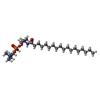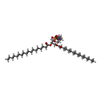+ Open data
Open data
- Basic information
Basic information
| Entry | Database: PDB / ID: 7lch | |||||||||
|---|---|---|---|---|---|---|---|---|---|---|
| Title | The mature Usutu SAAR-1776, Model B | |||||||||
 Components Components |
| |||||||||
 Keywords Keywords | VIRUS / Flavivirus / envelope glycoprotein | |||||||||
| Function / homology |  Function and homology information Function and homology informationribonucleoside triphosphate phosphatase activity / viral capsid / double-stranded RNA binding / methyltransferase cap1 activity / mRNA 5'-cap (guanine-N7-)-methyltransferase activity / RNA helicase activity / protein dimerization activity / symbiont-mediated suppression of host innate immune response / host cell endoplasmic reticulum membrane / serine-type endopeptidase activity ...ribonucleoside triphosphate phosphatase activity / viral capsid / double-stranded RNA binding / methyltransferase cap1 activity / mRNA 5'-cap (guanine-N7-)-methyltransferase activity / RNA helicase activity / protein dimerization activity / symbiont-mediated suppression of host innate immune response / host cell endoplasmic reticulum membrane / serine-type endopeptidase activity / viral RNA genome replication / RNA-directed RNA polymerase activity / fusion of virus membrane with host endosome membrane / symbiont entry into host cell / virion attachment to host cell / host cell nucleus / virion membrane / structural molecule activity / proteolysis / extracellular region / ATP binding / metal ion binding / membrane Similarity search - Function | |||||||||
| Biological species |  Usutu virus Usutu virus | |||||||||
| Method | ELECTRON MICROSCOPY / single particle reconstruction / cryo EM / Resolution: 2.35 Å | |||||||||
 Authors Authors | Khare, B. / Klose, T. / Fang, Q. / Kuhn, R. | |||||||||
| Funding support |  United States, 2items United States, 2items
| |||||||||
 Citation Citation |  Journal: Proc Natl Acad Sci U S A / Year: 2021 Journal: Proc Natl Acad Sci U S A / Year: 2021Title: Structure of Usutu virus SAAR-1776 displays fusion loop asymmetry. Authors: Baldeep Khare / Thomas Klose / Qianglin Fang / Michael G Rossmann / Richard J Kuhn /  Abstract: Usutu virus (USUV) is an emerging arbovirus in Europe that has been increasingly identified in asymptomatic humans and donated blood samples and is a cause of increased incidents of neuroinvasive ...Usutu virus (USUV) is an emerging arbovirus in Europe that has been increasingly identified in asymptomatic humans and donated blood samples and is a cause of increased incidents of neuroinvasive human disease. Treatment or prevention options for USUV disease are currently nonexistent, the result of a lack of understanding of the fundamental elements of USUV pathogenesis. Here, we report two structures of the mature USUV virus, determined at a resolution of 2.4 Å, using single-particle cryogenic electron microscopy. Mature USUV is an icosahedral shell of 180 copies of envelope (E) and membrane (M) proteins arranged in the classic herringbone pattern. However, unlike previous reports of flavivirus structures, we observe virus subpopulations and differences in the fusion loop disulfide bond. Presence of a second, unique E glycosylation site could elucidate host interactions, contributing to the broad USUV tissue tropism. The structures provide a basis for exploring USUV interactions with glycosaminoglycans and lectins, the role of the RGD motif as a receptor, and the inability of West Nile virus therapeutic antibody E16 to neutralize the mature USUV strain SAAR-1776. Finally, we identify three lipid binding sites and predict key residues that likely participate in virus stability and flexibility during membrane fusion. Our findings provide a framework for the development of USUV therapeutics and expand the current knowledge base of flavivirus biology. | |||||||||
| History |
|
- Structure visualization
Structure visualization
| Movie |
 Movie viewer Movie viewer |
|---|---|
| Structure viewer | Molecule:  Molmil Molmil Jmol/JSmol Jmol/JSmol |
- Downloads & links
Downloads & links
- Download
Download
| PDBx/mmCIF format |  7lch.cif.gz 7lch.cif.gz | 310.2 KB | Display |  PDBx/mmCIF format PDBx/mmCIF format |
|---|---|---|---|---|
| PDB format |  pdb7lch.ent.gz pdb7lch.ent.gz | 255.8 KB | Display |  PDB format PDB format |
| PDBx/mmJSON format |  7lch.json.gz 7lch.json.gz | Tree view |  PDBx/mmJSON format PDBx/mmJSON format | |
| Others |  Other downloads Other downloads |
-Validation report
| Summary document |  7lch_validation.pdf.gz 7lch_validation.pdf.gz | 1.5 MB | Display |  wwPDB validaton report wwPDB validaton report |
|---|---|---|---|---|
| Full document |  7lch_full_validation.pdf.gz 7lch_full_validation.pdf.gz | 1.5 MB | Display | |
| Data in XML |  7lch_validation.xml.gz 7lch_validation.xml.gz | 59.9 KB | Display | |
| Data in CIF |  7lch_validation.cif.gz 7lch_validation.cif.gz | 84.9 KB | Display | |
| Arichive directory |  https://data.pdbj.org/pub/pdb/validation_reports/lc/7lch https://data.pdbj.org/pub/pdb/validation_reports/lc/7lch ftp://data.pdbj.org/pub/pdb/validation_reports/lc/7lch ftp://data.pdbj.org/pub/pdb/validation_reports/lc/7lch | HTTPS FTP |
-Related structure data
| Related structure data |  23273MC  7lcgC M: map data used to model this data C: citing same article ( |
|---|---|
| Similar structure data |
- Links
Links
- Assembly
Assembly
| Deposited unit | 
|
|---|---|
| 1 | x 60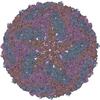
|
| 2 |
|
| 3 | x 5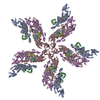
|
| 4 | x 6
|
| 5 | 
|
| Symmetry | Point symmetry: (Schoenflies symbol: I (icosahedral)) |
- Components
Components
| #1: Protein | Mass: 53623.812 Da / Num. of mol.: 3 / Fragment: UNP residues 294-793 Source method: isolated from a genetically manipulated source Source: (gene. exp.)  Usutu virus / Strain: SAAR-1776 / Cell line (production host): Vero / Production host: Usutu virus / Strain: SAAR-1776 / Cell line (production host): Vero / Production host:  Chlorocebus aethiops (grivet) / References: UniProt: Q5WPU4 Chlorocebus aethiops (grivet) / References: UniProt: Q5WPU4#2: Protein | Mass: 8333.710 Da / Num. of mol.: 3 / Fragment: UNP residues 219-293 Source method: isolated from a genetically manipulated source Source: (gene. exp.)  Usutu virus / Strain: SAAR-1776 / Cell line (production host): Vero / Production host: Usutu virus / Strain: SAAR-1776 / Cell line (production host): Vero / Production host:  Chlorocebus aethiops (grivet) / References: UniProt: A0A0H3U5P6 Chlorocebus aethiops (grivet) / References: UniProt: A0A0H3U5P6#3: Chemical | #4: Chemical | #5: Sugar | ChemComp-NAG / Has ligand of interest | Y | Has protein modification | Y | |
|---|
-Experimental details
-Experiment
| Experiment | Method: ELECTRON MICROSCOPY |
|---|---|
| EM experiment | Aggregation state: PARTICLE / 3D reconstruction method: single particle reconstruction |
- Sample preparation
Sample preparation
| Component | Name: Usutu virus / Type: VIRUS / Details: Virus purified using Vero cells. / Entity ID: #1-#2 / Source: RECOMBINANT | ||||||||||||||||||||
|---|---|---|---|---|---|---|---|---|---|---|---|---|---|---|---|---|---|---|---|---|---|
| Source (natural) | Organism:  Usutu virus / Strain: SAAR-1776 Usutu virus / Strain: SAAR-1776 | ||||||||||||||||||||
| Source (recombinant) | Organism:  Chlorocebus aethiops (grivet) / Cell: Vero cells Chlorocebus aethiops (grivet) / Cell: Vero cells | ||||||||||||||||||||
| Details of virus | Empty: NO / Enveloped: YES / Isolate: STRAIN / Type: VIRION | ||||||||||||||||||||
| Natural host | Organism: Turdus merula | ||||||||||||||||||||
| Buffer solution | pH: 8 / Details: 20 mM Tris, 120 mM NaCl, 1 mM EDTA, pH 8.0 | ||||||||||||||||||||
| Buffer component |
| ||||||||||||||||||||
| Specimen | Embedding applied: NO / Shadowing applied: NO / Staining applied: NO / Vitrification applied: YES | ||||||||||||||||||||
| Specimen support | Grid material: COPPER / Grid type: PELCO Ultrathin Carbon with Lacey Carbon | ||||||||||||||||||||
| Vitrification | Instrument: GATAN CRYOPLUNGE 3 / Cryogen name: ETHANE |
- Electron microscopy imaging
Electron microscopy imaging
| Experimental equipment |  Model: Titan Krios / Image courtesy: FEI Company |
|---|---|
| Microscopy | Model: FEI TITAN KRIOS |
| Electron gun | Electron source:  FIELD EMISSION GUN / Accelerating voltage: 300 kV / Illumination mode: FLOOD BEAM FIELD EMISSION GUN / Accelerating voltage: 300 kV / Illumination mode: FLOOD BEAM |
| Electron lens | Mode: BRIGHT FIELD / Nominal magnification: 64000 X / Nominal defocus max: 2000 nm / Nominal defocus min: 800 nm / Cs: 2.7 mm / C2 aperture diameter: 100 µm / Alignment procedure: COMA FREE |
| Specimen holder | Cryogen: NITROGEN / Specimen holder model: FEI TITAN KRIOS AUTOGRID HOLDER |
| Image recording | Average exposure time: 2.08 sec. / Electron dose: 23.68 e/Å2 / Detector mode: SUPER-RESOLUTION / Film or detector model: GATAN K3 BIOQUANTUM (6k x 4k) / Num. of grids imaged: 1 / Num. of real images: 3689 |
| EM imaging optics | Energyfilter name: GIF Bioquantum / Energyfilter slit width: 20 eV |
| Image scans | Movie frames/image: 40 |
- Processing
Processing
| Software | Name: PHENIX / Version: 1.19_4085: / Classification: refinement | ||||||||||||||||||||||||||||||
|---|---|---|---|---|---|---|---|---|---|---|---|---|---|---|---|---|---|---|---|---|---|---|---|---|---|---|---|---|---|---|---|
| EM software |
| ||||||||||||||||||||||||||||||
| CTF correction | Type: PHASE FLIPPING ONLY | ||||||||||||||||||||||||||||||
| Symmetry | Point symmetry: I (icosahedral) | ||||||||||||||||||||||||||||||
| 3D reconstruction | Resolution: 2.35 Å / Resolution method: FSC 0.143 CUT-OFF / Num. of particles: 285180 / Algorithm: FOURIER SPACE / Symmetry type: POINT | ||||||||||||||||||||||||||||||
| Atomic model building | Space: REAL | ||||||||||||||||||||||||||||||
| Refinement | Highest resolution: 2.35 Å | ||||||||||||||||||||||||||||||
| Refine LS restraints |
|
 Movie
Movie Controller
Controller




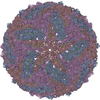
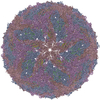
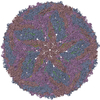
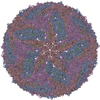
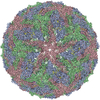
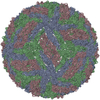
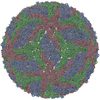



 PDBj
PDBj

